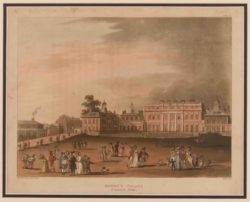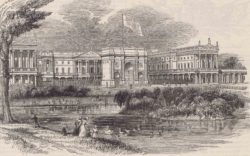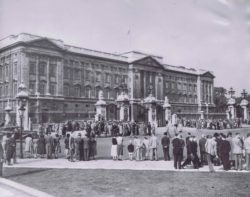Buckingham Palace, one of the most famous buildings in the country, and possibly the world, stands to the west of St James’s Park and south of Green Park. It has served as the official London residence of the UK’s sovereign since 1837 and is the monarch’s administrative centre, as well as a family home.

Queen’s Palace, St James’s Park
Engraved by Bluck after Pugin and Rowlandson, 1809
Collection no. S644
The basis of today’s palace is Buckingham House, built as a town house for the Duke of Buckingham in 1703. It became known as the Queen’s House in 1761 when it was acquired by George III for his wife, Queen Charlotte, to use as a comfortable family home; 14 of their 15 children were born there.

Buckingham Palace from the Park
Illustrated London News, 1842
Collection no. S157
In the late 1820s, George IV decided to turn the former Buckingham House into a palace. His architect, John Nash, doubled the size of the building and erected the Marble Arch to create a state entrance from The Mall. Buckingham Palace became Queen Victoria’s principal residence on her accession to the throne in 1837 but it soon proved too small for her growing family. In 1847, the Marble Arch was removed to allow a fourth wing to be built; it was re-erected in the north east corner of Hyde Park.

The East front of Buckingham Palace
Monochrome watercolour by TH Shepherd, c1850
Collection no. S712
The new east wing, facing onto The Mall, was built between 1847 and 1850 in response to Queen Victoria’s complaint about lack of space. It enclosed the earlier forecourt and created a new main façade for the palace. The most significant element was the central balcony, incorporated at Prince Albert’s suggestion, which has become famous as the stage on which the Royal family congregates to greet the crowds on important occasions.

Buckingham Palace – crowds gather to hear news of George VI following an operation to remove part of his lung
Photograph by J Davis for International News Photos, 23rd September 1951
Collection no. S378
The current forecourt, gates and railings were built as part of the creation of the Queen Victoria Memorial, the centrepiece of which is the large monument and statue of the Queen that stands in front of the palace and was unveiled in 1911. The east front of Buckingham Palace was redesigned in 1913 as a backdrop to the memorial, creating the façade that overlooks The Mall today.
